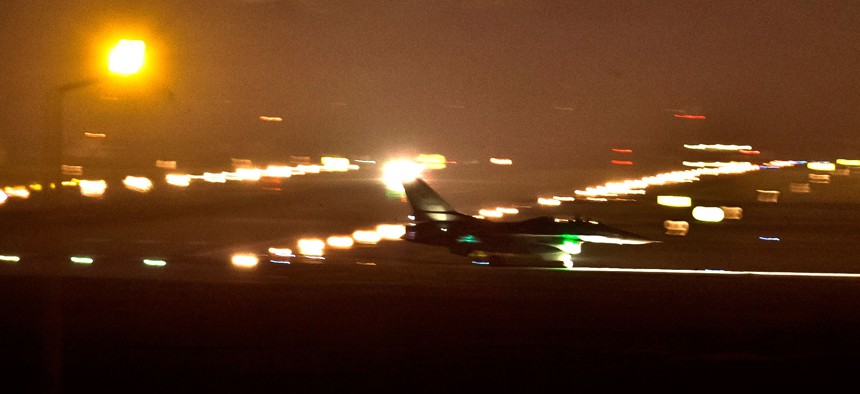
A Turkish fighter jets taxies on the runway after a night landing at the Incirlik airbase, southern Turkey, Aug. 31, 2013. Vadim Ghirda/AP
Turkey Opens Key Air Bases for US Strikes On ISIS
The newly approved use of Incirlik Air Base and others for bombing missions will greatly reduce the distance U.S. warplanes must fly to their targets.
Turkey will open up Incirlik Air Force Base, about 250 miles from the Syrian city of Raqqa, to U.S. and coalition strike operations against the Islamic State, or ISIS, Pentagon and Obama administration officials confirmed. The move puts anti-ISIS aircraft, which had been flying some 1,200 miles to strike enemy positions, much closer to the various battlegrounds, including Raqqa, the effective capital of the Islamic State in Syria.
"We have decided to further deepen our cooperation in the fight against ISIL. Access to Turkish bases such as Incirlik air base will increase the coalition's operational efficiency for counter-ISIL efforts, including airstrikes," said Capt. Jeff Davis, Pentagon spokesman, in a statement provided Thursday to Defense One, which earlier had reported that Turkish press reported the reversal in Turkish policy over the weekend. "As allies, we take threats to Turkey's border very seriously. Our cooperation will provide the coalition operational flexibility to respond to these threats, especially those emanating from Syria."
It’s a shift long sought by Washington, which has been trying to get Turkey's permission to launch strike missions from Incirlik ever since the air campaign began last August. The Pentagon has long operated from the Turkish air base, but has been denied approval to do more against ISIS than support U.S. and NATO aircraft passing through the region.
Obama administration officials confirmed that manned and unmanned U.S. warplanes will carry out strikes from Turkey, with one senior administration official describing the development as a “game changer.” It's unclear still which bases the U.S. actually will use.
“You can get there quick, you can stay longer and you can carry more [bombs],” said T. Michael Moseley, a retired Air Force general who was the head of U.S. Air Forces Central Command during the 2003 American-led invasion of Iraq. “It’s a good thing.”
Moseley also predicted political benefits from Turkey’s decision to increase its participation in the fight against ISIS. “The biggest thing is you’ve got a coalition partner that’s now visible … who happens to be a Sunni state [and] happens to be a NATO partner,” he said.
A month after the airstrikes began, then-Defense Secretary Chuck Hagel paid a visit to Turkey; the Turkish government maintained a low profile, closing nearly every event to the U.S. press traveling with the secretary. At the time, nearly 50 Turkish citizens had been taken hostage by ISIS in northern Iraq. Turkey negotiated their release later that month.
The agreement that opened the base to strike missions is a few weeks old, the Turkish newspaper Hürriyet reported. “The two sides agreed in principle about the use of the İncirlik base in Adana during talks on July 7-8,” it said.
But a recent terror attack inside Turkey may have added a certain urgency to Ankara’s response to the Islamic State. On Monday, 31 people were killed when a bomb exploded in the Turkish city of Suruc. Turkish authorities have blamed the attack on a student, Seyh Abdurrahman Alagoz, whom they said has ties to the Islamic State.
Obama spoke with Turkish President Recep Tayyip Erdogan over the phone Tuesday, where he gave his condolences to the families of the victims, and "discussed efforts to increase cooperation to stem the flow of foreign fighters and secure Turkey’s border with Syria,” according to a White House press statement.
Staging fighter and attack aircraft in Turkey would greatly reduce the distance they need to fly to reach a target, said David Deptula, a retired Air Force lieutenant general who was the principal attack planner for the Desert Storm air campaign against Iraq in 1991 and is now dean of the Mitchell Institute for Aerospace Studies.
Many American and coalition warplanes now fly as many as 1,200 miles from bases outside Iraq or aircraft carriers in the Persian Gulf to targets in Northern Iraq and Syria. ISIS strongholds, which have been the targets of airstrikes, are much closer to Turkey.
“What it does is it dramatically reduces the distance” to targets, Deptula said. “It means that with the same number of aircraft available that exist today, the number of strike sorties or missions that can be flown can be dramatically increased probably on the order of two to three times what we’re flying today.”
Basing strike aircraft in Turkey also reduces the demand on aerial tankers, which must refuel gas-hungry fighter jets multiple times when they come from other bases south of Iraq. They plans can also fly over targets for longer amounts of time.
The Incirlik base has played a critical role in various previous U.S.-led campaigns, including against Saddam Hussein and the Taliban in Afghanistan.
Molly O'Toole contributed to this report from Washington. Kevin Baron contributed from Aspen, Colo.